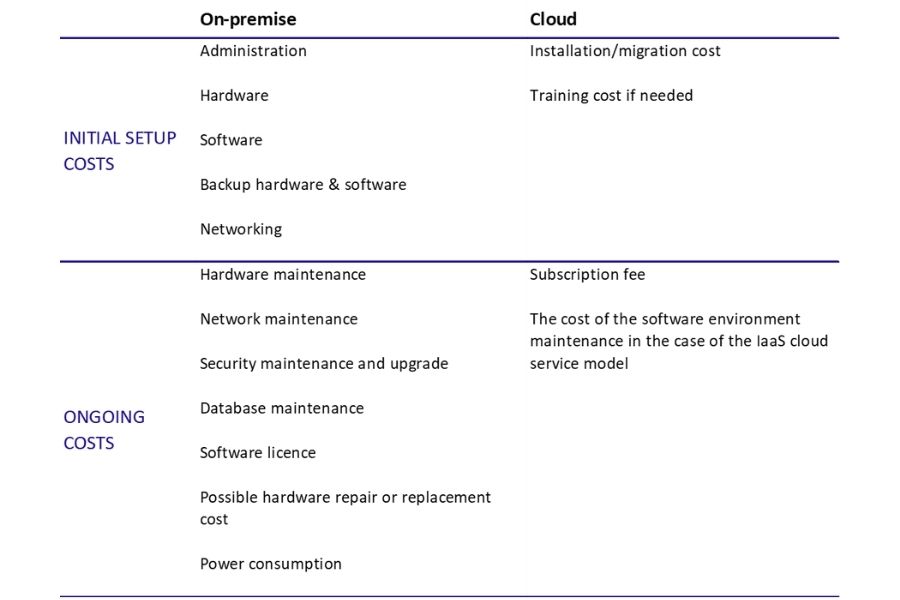On-premise vs cloud: pros and cons comparison to dispel all your doubts
Is the cloud safe? What will my business get from it? Is it really worth the hassle?
If the cloud topic has recently appeared on your business agenda, you’ve probably asked yourself these questions many a time.
There are a lot of myths and misconceptions around the cloud, especially in terms of security and costs. In this post, we’ll look at the pros and cons of the cloud vs. on-premise to help you decide whether the cloud is the way to go for you.
What are the benefits of cloud computing vs on-premise?
A less complicated setup process
With on-premise infrastructure, your team is responsible for all the setup: from connecting the machines to electricity through to installing all the software. With the cloud, this responsibility lies to a greater or lesser extent on the cloud service provider. The scope of it is determined by the cloud service model you choose.
For example, when you use the IaaS cloud service model your developers need to take care of the environment setup: install the operating system and all the necessary applications. In SaaS, on the other hand, you don’t need to worry about any such thing – you get a ready-made solution that you can start using straight off.
Read more about the differences between IaaS, PaaS and SaaS >>
More flexibility and scalability
With the cloud, it’s easier to scale the infrastructure up or down according to your changing needs. If you need more computing power, you can have another virtual machine allocated to your use or the other way round in case you don’t need so many resources. Having the infrastructure on-premise, you’re limited to your server room’s space.
Business requires you to allocate your data in a specific country? If the cloud provider offers such an option, you can do it.
Cost efficiency
Don’t need to use your resources round-the-clock? Public cloud offers a pay-per-use payment model. This means you pay only for the time you actually use it, let’s say during your company’s working hours, and at night the service will be switched off. This way you can use your budget more efficiently and make some savings.
Also, with the cloud, you can save on infrastructure management. Keeping it on-premise is connected with investing in it upfront and having responsibility for its maintenance. Not to mention, the time and effort that goes with it. You need an in-house IT team or hired third-party support to fix any possible technical issues and make necessary upgrades to keep the machines in shape.
Another advantage the cloud (in this case the public cloud) has over on-premise is that the software licence is often included in the price and you can use it as long as you use the service without any extra cost.
What are the disadvantages of cloud computing vs on-premise?
Less control over the hardware
However, just a bit less. In the IaaS cloud service model, you can control the resources such as the memory, RAM, CPU, or what kind of drives you want to use (however, not their brand), which allows you to customize the solution to your specific needs.
Possible compliance issues
In general, cloud providers offer tools to keep their user’s data secure and ensure compliance with various regulations, such as PCI DSS or HIPAA / HITECH. However, you should do your due diligence check to make sure this is really the case.
Is the cloud safer than on-premise?
Cloud providers, especially big vendors who offer public cloud model maintain high-security standards and have access to the cutting-edge security solutions that a middle-sized company with on-premise servers may never afford.
However, in both cases, cloud and on-premise, taking care of data security is your job. Cloud providers give you the tools to keep your data secure (according to the shared responsibility principle), but you need to know how to make good use of them to stay safe.
Is the cloud cheaper than on-premise?
In general, the cloud requires significantly lower investment upfront in comparison to on-premise. This makes it a go-to option for startups or companies that can’t afford big, long-term capital expenditure and would rather retain flexibility.
Once set up, all the ongoing costs are included in your subscription fee, which may vary based on your specific configuration. Plus, using a public cloud, you don’t have to pay extra for the software licence.
And how does on-premise compare? Let’s do a simplified cost breakdown:

Nonetheless, the simplified cost breakdown above shows that if you decide on on-premise, you need to take into consideration the ongoing hardware maintenance, upgrade and possible repair costs or even buying new machines in case some break down in the meantime. That’s quite a high entry barrier for companies that aren’t ready for such investments. It’s difficult to provide the exact, one-size-fits-all cost estimates for both solutions as a lot depends on the provider you choose and specific configuration tailored to your needs.
Should you migrate to the cloud or stay on-premise?
The benefits of cloud go way beyond what on-premise can give you. Plus, there are almost no limitations or risks involved in using the cloud. This makes cloud a go-to option in most cases. If you wonder about migration process, here you can check how we do that >>
Yet, in some scenarios, for example, when you need a highly customised server or a very special type of environment, the cloud may not be an ideal option and on-premise remains a necessity.
Are you considering cloud adoption? We can advise you on the best-suited option for your specific business case and take care of the whole process. Check how we do it >>
About the author
RECOMMENDED ARTICLES





